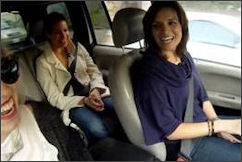 When historians look back upon the cultural history of the United States, they may well conclude that the greatest contribution of the Millennial Generation was its embrace of the sharing economy. Previous generations of Americans assumed as a bedrock principle that it made sense to own their major personal assets: cars and houses. Young people today aren’t so sure. And that presents a challenge to cities and towns, especially in the formulation of transportation policy.
When historians look back upon the cultural history of the United States, they may well conclude that the greatest contribution of the Millennial Generation was its embrace of the sharing economy. Previous generations of Americans assumed as a bedrock principle that it made sense to own their major personal assets: cars and houses. Young people today aren’t so sure. And that presents a challenge to cities and towns, especially in the formulation of transportation policy.
New technologies have made it possible for people to conduct new kind of transactions that were never practicable before — renting someone’s bike, borrowing a neighbor’s buzz saw, boarding a pet in someone else’s home, renting someone’s spare bedroom, even swapping services. There is no way of knowing how many of the start-up ventures peddling these ideas will survive, but it’s likely that a good many of them will. Young people are taking to them readily, suggesting a lasting sea-change in cultural attitudes.
For the purposes of this blog, the sharing economy is transforming transportation with an array of peer-to-peer services for sharing cars, rides and even parking spaces.
In an article exploring the implications of the sharing economy for local governments, Governing magazine quotes John Zimmer, co-founder of the Lyft service in which riders and drivers connect through smart phones. Of all cars on the road on any given day, he says, about 80% of the seats are empty. “There are idle cars. There are even idle people. It’s an information problem. We need to collect all the information about who needs these things and who has these things, and then we’ll have a much more efficient economy.”
The immediate advantage of this movement to local governments is that providing another transportation option will allow some people to reduce the number of cars in their households or, in extreme cases, go car-free. Fewer cars translates into less traffic congestion and the need for less parking (space that could be converted to more valuable uses). Also, the availability of such services is an amenity that makes a community more desirable to the demographic segments most likely to use them.
The difficulty is that these new services threaten the viability of traditional, highly regulated services like taxicabs and limo services. Governing cites the example of Seattle where taxi drivers, among other requirements, must take English-proficiency exams, pass a criminal background check, and pass a test on knowledge of local geography, regulations and driver conduct. Governments typically also set taxi fares and limit competition.
In 1979 Seattle tried deregulating its taxi service as a way to create jobs, lower taxi fares and reduce administrative expense. Consumer complaints jumped. Customers encountered dirty cars, inconsistent rates and drivers who refused to give short-haul rides. Public outcry led to the re-imposition of regulation.
That was 34 years ago. A few things have changed. When everyone has GPS navigation, do drivers really need to have an intimate knowledge of a city’s geography? When riders have tools to rate the quality of their service, don’t drivers have every incentive to be friendly, speak English and keep their cars clean?
I think we’re just seeing just the preliminary wave of change. Many more innovations will follow — chasing down possibilities we cannot even imagine today. Local governments should do everything within their power to foster this revolution, not retard it. Not every new business model will work. The process won’t always be pretty. Some people will complain. Some regulation to protect the public safety may be required — minimum insurance policies, criminal background checks, restrictions on drug and alcohol use, that sort of thing. Localities that get the right policy mix will reap rewards in greater mobility and livability for its citizens.
— JAB


